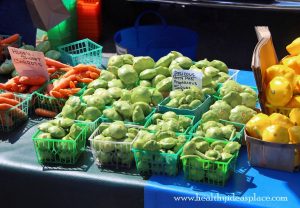The Benefits of Eating Local


The majority of food at any given meal I ate as a young child was local . . . very local. Most of it was grown in my family’s back yard by my mom or raised in the cattle yard or corn fields by my dad. Even in winter, we ate food produced during the summer that was canned or frozen to eat in the winter. You cannot get much more local than that.
How we define local these days is different. In fact, it’s an ambiguous term. There is no set definition. For some people it means procuring food for their table from sources no more than 5 or 10 miles away in any direction. For others it may be food produced in their county, or their state, or the larger region where they live. Personally, I like to think of local as food grown as close to home as possible and handled by as few people as possible.
That’s why I like farmer’s markets, CSA’s (Community-Supported Agriculture), pick-your-own farms, and buying directly from farmers when possible. They fit that definition. But, why eat local when you can purchase almost everything you want to eat at the grocery store or supermarket in one trip? Why go to all the trouble of seeking out other sources of food for your table? Since this week is National Farmer’s Market Week, let’s answer those questions and take a look at the benefits of eating local.
Benefits of Local Food
- Nutritional value – The food you buy is healthier than most comparable supermarket items since it is picked at or very close to its peak of ripeness. And produce picked at that time generally has a higher nutrient content than that picked before it is ripe. In addition, the nutritional value of food decreases with time and exposure to light and air. So the fresher it is, and the closer it is picked to its peak of ripeness, the greater the nutritional value.

- Knowledge of food – You can talk with and get to know the farmer who grew or produced the food you are buying. You can ask questions about the food and how it was grown. Were pesticides used or is it organic? What organic methods were used? You can learn about the varieties he grows and why he chose them. Many farmers and gardeners choose their varieties because they taste better or are better nutritionally. If you are unfamiliar with a type of food they can tell you about it and how to use it in cooking. Some will offer recipes or even a taste of the food before you purchase it. This is a wonderful learning experience for kids too. Think of all the varieties of produce they can experience by touching, seeing, and tasting them.

- Preserves diversity in our food systems – Many farmers and gardeners grow heirloom varieties in order to keep those varieties alive and well. Nutrient content varies within the different varieties of produce. For example, not all salad greens have the same nutrient make up, nor do all squash, or corn, or apple varieties. Consuming different varieties helps you obtain a more nutrient dense diet. Did you know there are about 2500 varieties of apples grown in the United States? While you won’t find all of them at your local farmer’s market, you will likely find more variety than in your neighborhood supermarket.
- Good for the economy – Buying local puts your money back into the community and supports your local farmers and gardeners, keeping them in business. It also helps keep more farm land and green space in your area, leading to a healthier living environment.
- Builds community – As you talk with and get to know the people selling at the farmer’s market or growing your food for your CSA, you develop a bond of trust and community.
- Reduced environmental impact – Food doesn’t have to travel as far to get to your table. That means less energy and fuel used for transportation and less pollution in the air.
- Flavor – The food tastes better. It just does. Bite into a fresh-from-the-garden tomato in August and compare it to the flavor of one purchased at the supermarket that was picked a couple of weeks before and traveled miles upon miles to get to your table. There is a huge difference in flavor. Don’t believe me? Try it. And it’s not just tomatoes. Apples picked fresh from the tree, grapes ripe off the vine, grass-fed beef, sweet corn fresh from the field, a carrot pulled right from the garden. All these taste better because they are picked when ripe.

Farmer’s markets, CSA’s, pick-your-own farms, and buying direct from farmer’s are great ways to enjoy all the benefits of eating local. Want to try buying local but not sure how to do it? Here are some resources to help you find a local farmer’s market, CSA, or pick-your-own farm.
Resources
Local Harvest is a website where you can put in your zip code and find local CSA’s, farmer’s markets, pick-your-own farms, and other places where you can find locally produced food.
http://www.localharvest.org/csa/
The USDA has a Farmer’s Market Directory that you can search by zip code.
http://search.ams.usda.gov/farmersmarkets/
Pick Your Own is a site where you can find pick-your-own farms close to you.
Are you a member of a CSA? Do you frequently visit farmer’s markets or pick-your-own farms? What’s your favorite way to eat local? Let me know in the comments below!


